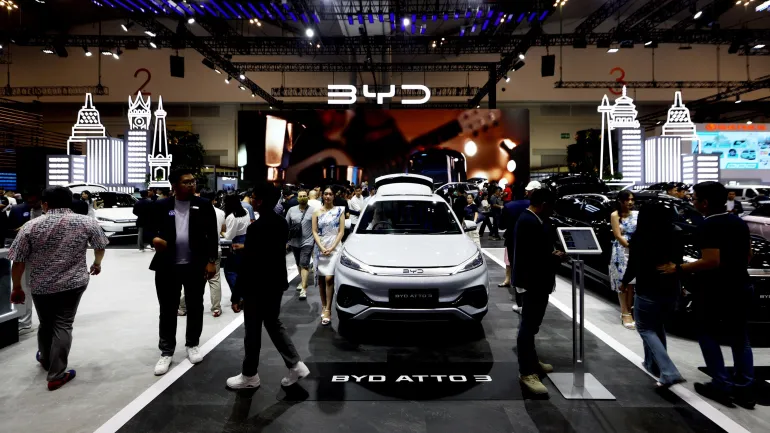Green Soft Power: China’s New Strategy in Europe


In a situation of geopolitical tensions, China has found in green technologies a way of mending its economic and diplomatic relations with Europe. Through the electric vehicle sector, China is constructing a new form of prestige and international soft power.
In the last five years, relations between the European Union and China have been marked by tensions and negative European perceptions of Beijing. The COVID pandemic and the war in Ukraine prompted debates on the risks of economic dependencies, and the challenge of the close relationship between Beijing and Moscow. Transatlantic re-engagement during Joe Biden’s mandate and United States’ support for the Ukrainian government led some European governments into a more aggressive stance towards Beijing and alignment with Washington. However, Donald Trump’s return to power is upsetting these balances. In recent months, the European Union has been making symbolic overtures and toning down its rhetoric about China in an attempt to consolidate its international position beyond the embattled western bloc. This process of re-establishing economic and political ties, which were quietly being woven even before Trump’s return, occurred through one of the leading sectors of the Chinese economy: electric vehicles (EV).
With rising investments in green technology in European countries, China has been able to improve its image in several of them by creating jobs and offering high-quality products at competitive prices. Without direct involvement from Brussels, several local and central governments of European states have strengthened their relations with China through this sector. In recent years, China has positioned itself as a green giant, thus developing a soft power that has helped it to create ties with a Europe that has similar climate objectives.
Private internationalisation, geopolitical gains
In the last five years of cooling political relations between the EU and China, the EV sector has been a key factor in maintaining economic relations between the two powers. By 2023, EV investments already accounted for 70% of Chinese direct foreign investment in Europe. China’s new EV-related manufacturing in Europe has mainly been concentrated (85%) in the batteries sector, with announcements in recent years of new factories in a wide variety of countries, including Hungary, France, Germany, Slovakia, Spain, and Poland. Moreover, the EU is already the largest export market for Chinese-made EVs.
This internationalisation of EV companies in Europe was not a premeditated strategy of the Beijing government but was mainly initiated by the Chinese private sector in response to high levels of domestic competition. After years of a highly successful industrial policy, China has consolidated as the great power in EV production as it now produces 60% of the world’s EVs and 80 of the batteries. Both Chinese companies like BYD and foreign companies that are manufacturing in China, like Tesla, have benefitted, leading to fierce domestic competition despite the market distortions that subsidies and public funding tend to generate. Furthermore, China is now positioned as a leading hub of high-level innovation in batteries, which currently represent more than a third of the cost of an EV.
Nevertheless, with a declining domestic demand owing to the Chinese economic slowdown, and faced with a very competitive offer of supply, Chinese companies, and also foreign companies operating in China, have decided that they need to expand the markets where their products can be sold. To secure new customers, avoid tariffs, and mitigate adverse policy measures, several electric vehicle and battery manufacturers opted not only to sell in Europe but also to manufacture in Europe. This has forged new economic ties between China and the EU and has helped to establish more positive relationships between Chinese companies and authorities and the European governments receiving this investment. The core position of the EV sector in these bilateral relations is patent in the prominence of the sector in diplomatic visits of European leaders to China in the last few years, among them those by Giorgia Meloni and Pedro Sánchez.
Protection of industries and climate emergency
The green technologies sector has been able to circumvent the dynamics of securitisation and de-risking that marked the EU’s China strategy in the years of geopolitical distancing. Unlike other technologies like 5G or AI, electric vehicles are not perceived as a significant risk for national security and defence. Moreover, the present boom is consistent with the ambitious climate goals shared by both the European Union and China with carbon neutrality targets in 2050 and 2060, respectively. China’s success in the areas of electric vehicles and renewable energy is one of the few vectors by means of which China can exercise some degree of soft power in Europe thanks to a positive climate image and prestige as a leader in the field.
However, China’s ability to establish its positioning has not come about without tensions in the EU and its member states. For example, when the European Union decided to introduce tariffs of up to 45% on Chinese-made EVs in an attempt to protect the European automobile industry, several member states voted against the proposal or abstained because of their priorities of retaining their industrial presence in China, or attracting and/or consolidating Chinese investment within their national borders. In addition, the existence of these tariffs points to a crucial trade-off facing the EU: prioritising protection of its industry or confronting the climate emergency. Imposing tariffs on electric vehicles necessarily increases their price, which will slow down their acceptance. In this regard, Chinese subsidies to the sector could be perceived in two contrasting ways: either as state aid that is damaging to European companies, or as a subsidy at the expense of the Chinese taxpayer, from which European consumers can benefit in the form of cheaper prices.
Second, the establishment in Europe of Chinese factories and joint ventures between Chinese and European partners has led to debate as to whether the EU should copy the industrial innovation strategy of Deng Xiaoping’s China, which is to say, make Chinese industrial presence conditional on technological transfer since Chinese companies are now the more advanced and innovative part of the relationship. For the time being, in the absence of a common European strategy, the chances of imposing this transfer seem slim. If an EU country insists on stricter conditions, the Chinese companies can always move to other, less demanding member states.
Beyond these debates, the success of China’s green strategy in Europe is evidence that Beijing is strengthening its position as the leading green power, whether in advanced markets like those of Europe or in developing economies like those of the Global South, where its competitive prices are even more attractive. China is managing to create a new kind of green soft power that does not need Beijing’s stultifying propaganda. Its material success speaks for itself. It remains to be seen in the coming months whether Donald Trump’s attempts to make many countries take a stand against China will be sufficient to obstruct China’s new path to influence in the world.
Keywords: EU, China, geopolitics, soft power, green technologies, electric vehicles, de-risking
All the publications express the opinions of their individual authors and do not necessarily reflect the views of CIDOB or its donors.